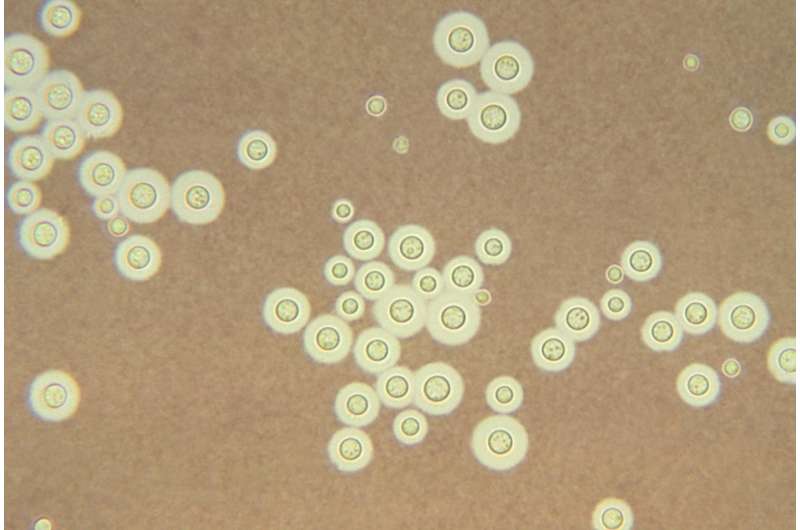Deadly fungus uses unexpected system to control its virulence

A research team led by UC San Francisco scientists has discovered a cellular signaling system that regulates the virulence of Cryptococcus neoformans, a fungus that has been estimated to cause nearly a million cases of meningitis worldwide per year, about 625,000 of which are fatal. C. neoformans infections are a particular threat to individuals whose immune systems are compromised—meningitis caused by this fungus is responsible for as much as 40 percent of all deaths related to HIV/AIDS.
The signaling system in question, known as "quorum sensing," is common in bacteria, but nothing truly analogous has been documented in any pathogen in the family of eukaryotes, the term for the large and diverse group of organisms that includes fungi, plants, and animals, including humans.
"Nothing like this has been described in eukaryotic pathogen," said UCSF's Hiten Madhani, MD, PhD, professor of biochemistry and biophysics, and senior author of the new study, which is published in the May 19, 2016 issue of Cell Host & Microbe. "Finding out more about how this system works in detail could give us new perspectives that are potentially important to public health."
In quorum sensing, each individual in a colony of cells secretes specialized substances into the surrounding microenvironment that are detectable by receptor proteins present in all colony members. The number of receptors that respond in each cell is determined by the concentration of secretions in its neighborhood. The sum of these receptor responses regulates a variety of functions in that cell, such as whether or not genes that spur its growth are activated.
Madhani and colleagues discovered quorum signaling in C. neoformans in the course of an ongoing project, funded by the National Institutes of Health (NIH), to successively disable each of the fungus's nearly 7,000 genes in order to determine each gene's function. The group has now completed work on about 4,000 of these genes, and has made their findings freely available through the Fungal Genetics Stock Center, an online resource devoted to the biology of fungi.
In work led by UCSF graduate students Christina M. Homer and Diana K. Summers, the group noted that C. neoformans carrying mutations in one gene, which they subsequently named Quorum-Sensing-Like Peptide 1, or QSP1, formed abnormal colonies. "It grew just fine, but the colonies were sort of funny-looking," Madhani said, an observation that led the team to further explore the consequences of QSP1 mutations.
Mice usually succumb very quickly to C. neoformans infections, but the research group found that mice infected with strains carrying mutations in QSP1 lived twice as long as those infected with the normal fungus, indicating that the gene plays an important role in virulence.
Moreover, after 13 days, mice infected with QSP1-mutant C. neoformans had 20 times fewer viable fungal cells present in their lungs—the usual route of entry for fungal infections—as well as significantly lower markers of immune activity and inflammation.
"This is significant," Madhani said, "because it is almost never the case that we find a mutant where the mice are able to even partially clear the infection."
The QSP1 gene codes for a peptide, a short string of amino acids. In an intriguing sidelight, the researchers showed that C. neoformans secretes a precursor to this peptide that matures outside the cell. The fully formed peptide is then imported back into the cell to regulate virulence via its actions on a receptor that is yet to be identified.
Madhani said that antifungal drug development is generally focused on broad-spectrum medications that kill many species or completely block their virulence. Because quorum signaling is generally species-specific, and because QSP1 mutations tamp down virulence but do not eliminate it, he thinks it unlikely that a drug company would approach QSP1 as a therapeutic target in the near future.
But the gene and its peptide product may interact with targets that would be highly appropriate for drug development, Madhani said, and "the mere fact that we've shown that quorum signaling happens in a pathogenic eukaryote, and that it's important for virulence, is a significant advance for the field."
Journal information: Cell Host & Microbe
Provided by University of California, San Francisco



















